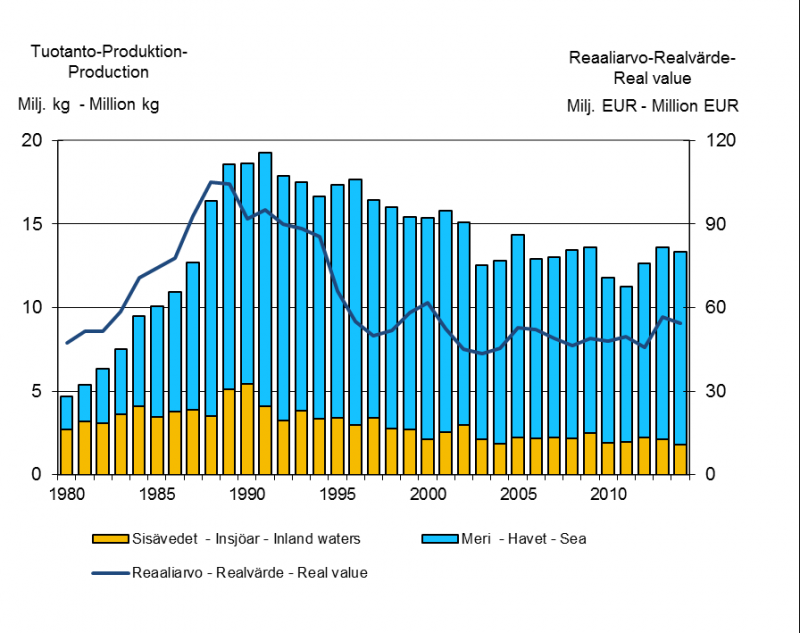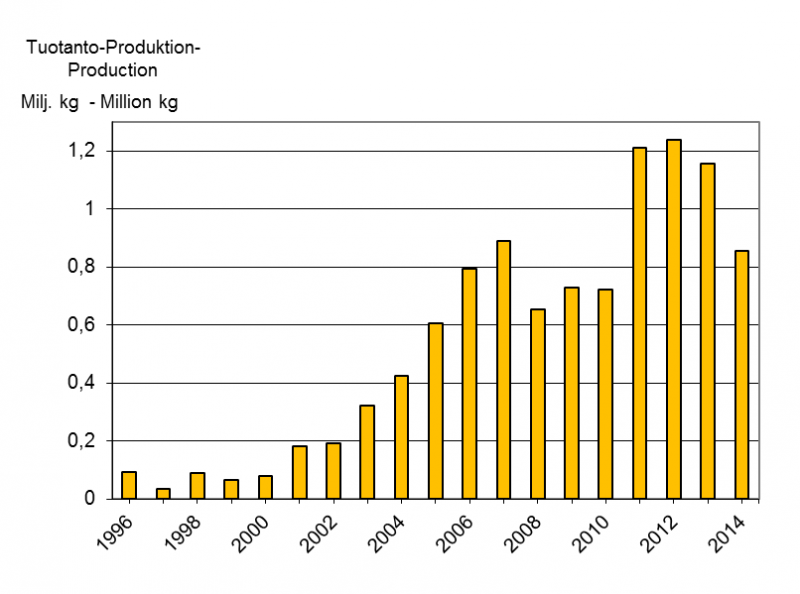The demand for edible fish bred in Finland exceeds supply

In 2014, some 13.3 million kilograms of fish were cultivated for human consumption in Finland. This represented a decrease of some 0.3 million kilograms compared to 2013. The value of farmed edible fish was slightly lower than in the previous year, the Natural Resources Institute's (Luke) aquaculture statistics reveals.
Rainbow trout is still the most significant species of edible fish farmed in Finland, even though its production volumes have dropped since its heyday in the1990s. Some 12.4 million kilograms of rainbow trout were produced in 2014, representing over 90 per cent of all the edible fish produced in Finland. A little under 0.9 million kilograms of European whitefish were produced, representing a decrease of some 0.3 million kilograms compared to 2013. A total of some 0.1 million kilograms of the other species of fish being farmed, including trot, arctic charr, sturgeon and pike perch, were produced. Some 0.4 million kilograms of rainbow trout roe were produced for food.
The value of rainbow trout produced in 2014 amounted to EUR 47.1 million, while the value of European whitefish totalled EUR 6.6 million. The value of all edible fish produced amounted to EUR 54.5 million, representing a decrease of some EUR 1.5 million compared to 2013. This change is largely explained by lower production volumes.
The majority of edible fish is produced in sea areas
As much as 86 per cent of the edible fish produced in Finland was bred in sea areas. Production in sea areas saw a slight increase, whereas production in inland water areas decreased compared to 2013. Åland produced 6.5 million kilograms of edible fish, while 3.9 million kilograms were produced in the coastal areas and archipelago of Southwest Finland. Some 1.1 million kilograms were produced in other sea areas. The edible fish produced in Finland's inland waters only amounted to 1.8 million kilograms.

The edible fish farmed in Finland was mainly consumed in Finland. Simultaneously, Finland imported 9.5 million kilograms of fresh rainbow trout and 32 million kilograms of fresh Norwegian salmon, Luke's previously published statistics on fish imports reveal.
"The demand for Finnish fish exceeds supply. Factors retarding the growth of domestic production include the breeding permits required by the Environmental Protection Act. These permits specifically stipulate where and how much fish can be farmed," states researcher Riitta Savolainen from Luke.
In addition to fish consumed as food, fish is also farmed in order to be planted in natural waters. Fry breeding is mainly concentrated in the regions of Lapland, Northern Ostrobothnia, Kainuu, and Central Finland. Some 56 million specimens of fry and crayfish – excluding newly hatched individuals – were produced for the purposes of stocking and additional farming.
In 2014, a total of 322 fish farming businesses operated in Finland. These businesses had 446 functional fish farms or natural-food farm ponds. Edible fish was bred at 164 of these facilities, and fry were cultivated at 99. Some 196 natural-food farm ponds existed in Finland.
Provided by Natural Resources Institute Finland


















